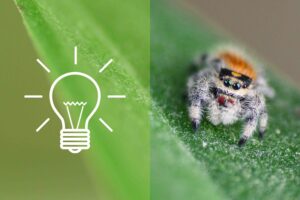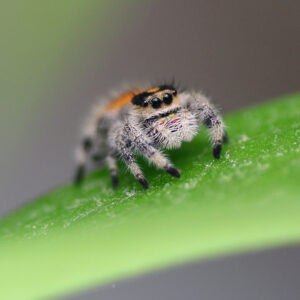Jumping spiders-Magazine
Jumping spider food – The right diet!
If you ask yourself the question about the right jumping spider food, the answer is basically very simple: as varied as possible! In everyday life, however, there are always other challenges and questions when feeding the little jumping spiders. How do I get the jumping spider food into the terrarium? Which food animals can I feed? Why won’t my spider eat? These and other questions will be answered in this article.
General information on the subject of spring spider nutrition
First of all, it is important to know that the right food for jumping spiders is exclusively different, living insects. One reason why jumping spiders are so special is the fact that they can catch food insects that are up to 1.5 times their size. The food insects are hunted on sight during the day and you can always observe their ability to jump when feeding the little ones. Bright lighting, enough warmth and a terrarium that is not too large are important for the animals to find their food and hunt successfully.
You can read more about this in the article on keeping jumping spiders. As a rule of thumb for a well-fed spider, its abdomen, i.e. its hindquarters, should not be larger than 1-1.5 times the size of its carapace, i.e. its “head”. If the abdomen of a spider is rather oval or elliptical, it could again tolerate food. If its abdomen appears plump and rather round, a feeding can be skipped without a guilty conscience. A slightly sunken, flat abdomen, on the other hand, is a sign of dehydration, so you should provide your spider with water again.
Which insects serve as food for jumping spiders?
In principle, all kinds of insects can serve as food for the jumping spider. However, it is important to make sure that the food animals are not larger than 1.5 times the size of your spider. It is also advisable to make sure that you vary the food animals and, for example, do not feed only grasshoppers. For example, you can always alternate between flies, house crickets, crickets, cockroaches, oven fish, grubs, etc.
In our experience, food animals that, like the spider, tend to stay in the upper part of the terrarium, such as flies and grasshoppers, are also particularly popular. However, not only these two should be used as food. Finally, it is important to know that some food insects, especially crickets, crickets, but also mealworms, can be dangerous to your spider while it is moulting. These insects may injure or even kill your spider when it is in the sensitive phase of moulting. For this reason, you should refrain from feeding these insects during this phase. Flies in particular, for example, cannot be dangerous to your spider. A selection of suitable food insects depending on spider size can be found here:
FH1-2:
FH3-4:
FH5-7:
ab FH7:
How do I get the food animals into the terrarium?
In order to get the food animals into the terrarium successfully and without breakouts, it makes sense to buy different tweezers. Spring steel and normal steel tweezers are particularly suitable. These can be used to catch the food animals on a pair of legs and transport them into the terrarium. Attention! Crickets and grasshoppers, for example, can throw off their last and largest pair of legs and thus still escape. For this reason, you should rather try to grab them by a front pair of legs to keep escape attempts to a minimum. Many other food insects such as Terfly or Drosophila can often be shaken directly from their sales box into the terrarium in portions. Another uncomplicated method of feeding is as follows: You put the desired number of maggots into the terrarium every week. These are much easier to dose with tweezers than flies. With this method, the jumping spider can eat a maggot directly or it will eat the resulting fly a few days later.
What can I do if my spider does not eat?
The most common husbandry mistakes with jumping spiders are insufficient lighting and too little heat. If your spider does not eat, try to move it to a brighter place and if necessary increase the temperature so that it is at least 26°C, but better at 28-30°C. If your spider still does not eat, it is possible that it is in a moulting phase. As a rule, a moulting phase announces itself in such a way that your spider becomes more inactive, stays frequently or exclusively in its web and spins it more densely. In this case, it is best to leave your spider alone and refrain from feeding until the moult is over and your animal shows itself outside again. Nevertheless, regular spraying should not be dispensed with during this phase, as high humidity helps the spider during moulting.
You can find our offspring for sale here:
If there are any further questions, feel free to ask them below the article in the comments.























When can I feed after a molt?
You can feed your jumping spider about 3 to 5 days after molting. After molting, its exoskeleton is still soft and needs time to harden before it can safely hunt prey again. Make sure the spider appears active and moves confidently before offering food.
If it ignores the food at first, that’s completely normal — just try again the next day. 😊
Best regards
Frank